Optimal Path Planning and Tracking Control Methods for Parafoil
Abstract
:1. Introduction
2. Model of Parafoil
3. Optimal Parafoil Path Planning Method
4. Optimal Flight Path Tracking Control Method for Parafoil
5. Simulation Results and Analysis
5.1. Path Planning for Parafoil
5.2. Path Tracking for Parafoil
6. Conclusions
Author Contributions
Funding
Data Availability Statement
Conflicts of Interest
Nomenclature
| b | Span of parafoil |
| c | Chord length of parafoil |
| Aspect radio | |
| Air-cell height | |
| Attack angle and sideslip angle | |
| Air density | |
| S | Reference area |
| Umbrella area | |
| m | Parafoil mass |
| P | Dynamic pressure |
| Lift, drag, and side force | |
| Lift, drag, and side force coefficient | |
| Axial force coefficient | |
| Roll, pitch, and yaw moment | |
| Roll, pitch, and yaw moment coefficient | |
| Symmetric downward bias of parafoil | |
| Asymmetric downward bias of parafoil | |
| Asymmetric control drag coefficient | |
| Asymmetric control lift coefficient | |
| sideslip angle induced Y-axis force coefficient | |
| Asymmetric control induced Y-axis force coefficient | |
| Y-axis aerodynamic coefficient induced by rotation about the Z-axis | |
| sideslip angle induced X-axis moment coefficient | |
| Asymmetric control induced X-axis moment coefficient | |
| X-axis moment coefficient induced by rotation about the X-axis | |
| X-axis moment coefficient induced by rotation about the Z-axis | |
| sideslip angle induced Z-axis moment coefficient | |
| Asymmetric control induced Z-axis moment coefficient | |
| Z-axis moment coefficient induced by rotation about the X-axis | |
| Z-axis moment coefficient induced by rotation about the Z-axis | |
| Asymmetric control induced Y-axis moment coefficient | |
| Y-axis moment coefficient induced by rotation about the Y-axis | |
| Velocity of parafoil | |
| Horizontal velocity of parafoil | |
| Projections of parafoil velocity on the body coordinate system | |
| Projections of tracking target on the body coordinate system | |
| Flight path inclination and deflection | |
| Position of parafoil on the earth coordinate system | |
| Rotational angular velocity | |
| Components of on the X, Y, and Z axes | |
| Pitch angle, yaw angle, and roll angle | |
| Yaw angle rate | |
| u | Control input |
Appendix A
Appendix B
References
- Goodrick, T.F. Theoretical study of the longitudinal stability of high performance gliding air drop systems. In Proceedings of the 5th Aerodynamics Deceleration Systems Conference, Albuquerque, NM, USA, 17–19 November 1975. [Google Scholar]
- Goodrick, T.F. Comparison of simulation and experimental data for a gliding parachute in dynamic flight. In Proceedings of the 7th Aerodynamic Decelerator and Balloon Technology Conference, San Diego, CA, USA, 21–23 October 1981. [Google Scholar]
- Goodrick, T.F. Scale effects on performance of ram air wings. In Proceedings of the 8th Aerodynamic Decelerator and Balloon Technology Conference, Hyannis, MA, USA, 2–4 April 1984. [Google Scholar]
- Yang, H.; Song, L.; Wang, W.J. 4-DOF longitudinal dynamic simulation of powered-parafoil. J. Beijing Univ. Aeronaut. Astronaut. 2014, 40, 1615–1622. [Google Scholar]
- Mortaloni, P.A.; Yakimenko, O.A.; Dobrokhodov, V. On the development of a six-degree-of-freedom model of a low-aspect-ratio parafoil delivery system. In Proceedings of the 17th AIAA Aerodynamic Decelerator Systems Technology Conference and Seminar, Monterey, CA, USA, 19–22 May 2003. [Google Scholar]
- Xiong, J.; Qin, Z.Z.; Wen, H.W. Optimal Control of Parafoil System Homing. Aerosp. Control 2004, 22, 32–36. [Google Scholar]
- Muller, S.; Wagner, O.; Sachs, G. A high-fidelity nonlinear multibody simulation model for parafoil systems. In Proceedings of the 17th AIAA Aerodynamic Decelerator Systems Technology Conference and Seminar, Monterey, CA, USA, 19–22 May 2003. [Google Scholar]
- Xiong, J.; Song, X.M.; Qin, Z.Z. Analysis on Two Body Relative Movement of Parafoil System. Spacecr. Recovery Remote Sens. 2004, 25, 10–16. [Google Scholar]
- Slegers, N.J. Effects of canopy-payload relative motion on control of autonomous parafoils. J. Guid. Control Dyn. 2010, 3, 116–125. [Google Scholar] [CrossRef]
- Vishnyak, A. Simulation of the payload-parachute-wing system flight dynamics. In Proceedings of the Aerospace Design Conference, Irvine, CA, USA, 16–19 February 1993. [Google Scholar] [CrossRef]
- Slegers, N.J.; Yakimenko, O. Optimal control for terminal guidance of autonomous parafoils. In Proceedings of the 20th the AIAA Aerodynamic Decelerator Systems Technology Conference and Seminar, Seattle, WA, USA, 4–7 May 2009. [Google Scholar]
- Zhang, L.; Gao, H.; Chen, Z.; Sun, Q.; Zhang, X. Multi-objective global optimal parafoil homing trajectory optimization via Gauss pseudo spectral method. Nonlinear Dyn. 2013, 72, 1–8. [Google Scholar] [CrossRef]
- Gao, H.; Zhang, L.; Sun, Q.; Sun, M.W.; Chen, Z.Q.; Kang, X.F. Fault-tolerance design of homing trajectory for parafoil system based on pseudo-spectral method. Control Theory Appl. 2013, 30, 702–708. [Google Scholar]
- Xie, Y.; Wu, Q.X.; Jiang, C.S.; Zheng, C. Application of Particle Swam Optimization Algorithm in Route Planning for Parafoil Airdrop System. Aero Weapon. 2010, 5, 7–10. [Google Scholar]
- Jiao, L.; Sun, Q.L.; Kang, X.F. Route Planning for Parafoil System Based on Chaotic Particle Swarm Optimization. Complex Syst. Complex. Sci. 2012, 9, 47–54. [Google Scholar]
- Pu, Z.G.; Li, L.C.; Tang, B.; Zhang, Y. Segmental homing direction control method for parafoil system. J. Ordnance Equip. Eng. 2009, 30, 117–119. [Google Scholar]
- Zhang, X.H.; Zhu, E.L. Design and Simulation in the Multiphase Homing of Parafoil System Based on Energy Confinement. Aerosp. Control 2011, 29, 43–47. [Google Scholar]
- Kaminer, I.I.; Yakimenko, O.A. On the development of GNC algorithm for a high-glide payload delivery system. In Proceedings of the 42nd IEEE Conference on Decision and Control, Maui, HI, USA, 1–4 October 2003. [Google Scholar]
- Liu, Z.; Kong, J. Path planning of parafoil system based on particle swarm optimization. In Proceedings of the 2009 International Conference on Computation Intelligence and Natural Computing, Beijing, China, 6–7 June 2009. [Google Scholar]
- Pini, G.; Sharoni, F. Coordination and communication of cooperative parafoils humanitarian aid. IEEE Trans. Aerosp. Electron. Syst. 2010, 46, 1747–1760. [Google Scholar]
- Jiang, H.C.; Liang, H.Y.; Zeng, D.T.; Jin, Y. Design of the optimal homing trajectory of a parafoil system considering threat avoidance. J. Harbin Eng. Univ. 2016, 37, 955–962. [Google Scholar]
- Tao, J.; Sun, Q.; Zhu, E.; Chen, Z.; He, Y. Genetic algorithm based homing trajectory planning of parafoil system with constraints. J. Cent. South Univ. Sci. Technol. 2017, 48, 404–410. [Google Scholar]
- Zhao, Z.H.; Zhao, M.; Chen, Q.; Cai, L.J. Design in Multiphase Homing of 4- DOF Parafoil System Based on Improved Artificial Fish- Swarm Algorithm. Fire Control Command. Control 2017, 42, 64–68. [Google Scholar]
- Gao, F.; Guo, R.; Feng, Z.; Jie, J.; Zhang, Q. Optimization Design of Homing Trajectory of Parafoil System with Five Segments. Acta Armamentarii 2020, 41, 1025–1033. [Google Scholar]
- Zhang, H.; Meng, X.J.; Chen, Z.L.; Zhang, Y.; Liu, Z. Trajectory Planning in Three Dimensions for Unmanned Parafoil Based on Compound Optimization RRT. J. Command. Control 2022, 8, 235–238. [Google Scholar]
- Xiong, J.; Cheng, W.K.; Qin, Z.Z. Trajectory tracking control of parafoil system based on Serret-Frencet coordinate system. J. Dyn. Control 2005, 3, 87–91. [Google Scholar]
- Hu, W.Z.; Chen, J.P.; Zhang, H.Y.; Tong, M.B. Dynamic Modeling and Flight Control Simulation of Parafoil Aerial Delivery Systems. Aeronaut. Comput. Tech. 2017, 47, 70–73. [Google Scholar]
- Qian, K.C.; Chen, Z.L.; Li, J. Autonomous Flight Control Method of Powered Paraglider Based on Dynamic Inversion. Control Eng. China 2011, 18, 178–180. [Google Scholar]
- Xie, Y.R.; Wu, Q.X.; Jiang, C.S. Trajectory Tracking of Parafoil Using FDO Based Nonlinear Predictive Control. Electron. Opt. Control 2011, 18, 72–76. [Google Scholar]
- Zhu, E.L.; Zhang, X.H. Design and application of fuzzy controller in parafoil airdrop system. Electron. Meas. Technol. 2011, 34, 46–49. [Google Scholar]
- Li, Y.X.; Chen, Z.Q.; Sun, Q.L. Flight path tracking of a parafoil system based on the switching between fuzzy control and predictive control. CAAI Trans. Intell. Syst. 2012, 7, 1–8. [Google Scholar]
- Culpepper, S.; Ward, M.B.; Costello, M.; Bergeron, K. Adaptive control of damaged parafoils. In Proceedings of the 22nd AIAA Aerodynamic Decelerator Systems (ADS) Conference, Daytona Beach, FL, USA, 25–28 March 2013. [Google Scholar]
- Rademacher, B.; Lu, P.; Strahan, A.; Cerimele, C. Trajectory design, guidance and control for autonomous parafoils. In Proceedings of the AIAA Guidance, Navigation and Control Conference and Exhibit, Honolulu, HI, USA, 18–21 August 2008. [Google Scholar]
- Rademacher, B.J.; Lu, P.; Strahan, A.L.; Cerimele, C.J. In-flight trajectory planning and guidance for autonomous parafoils. J. Guid. Control Dyn. 2009, 32, 1697–1712. [Google Scholar] [CrossRef] [Green Version]
- Benjamin, S.C. Adaptive control of a 10K parafoil system. In Proceedings of the 23rd AIAA Aerodynamic Decelerator Systems Technology Conference, Reston, VI, USA, 30 March–2 April 2015. [Google Scholar]
- Jann, T. Advanced features for autonomous parafoil guidance, navigation and control. In Proceedings of the 18th AIAA Aerodynamic Decelerator Systems Technology Conference and Seminar, Munich, Germany, 23–26 May 2005. [Google Scholar]
- Tao, J.; Sun, Q.; Chen, Z.; He, Y. LADRC-based trajectory tracking control for a parafoil system. J. Harbin Eng. Univ. 2018, 39, 510–516. [Google Scholar]
- Sun, Q.; Chen, S.; Sun, H.; Chen, Z.; Sun, M.; Tan, P. Trajectory tracking control of powered parafoil under complex disturbances. J. Harbin Eng. Univ. 2019, 40, 1319–1326. [Google Scholar]
- García-Beltrán, C.D.; Miranda-Araujo, E.M.; Guerrero-Sanchez, M.E.; Valencia-Palomo, G.; Hernández-González, O.; Gómez-Peñate, S. Passivity-based control laws for an unmanned powered parachute aircraft. Asia J. Control 2021, 23, 2087–2096. [Google Scholar] [CrossRef]
- Omar, H.M. Optimal Geno-Fuzzy Lateral Control of Powered Parachute Flying Vehicles. Aerospace 2021, 8, 400. [Google Scholar] [CrossRef]
- Carlos, M.; Mark, C. Avoiding Lockout Instability for Towed Parafoil Systems. J. Guid. Control Dyn. 2016, 39, 985–995. [Google Scholar]
- Cacan, M.; Costello, M. Adaptive Control of Precision Guided Airdrop Systems with Highly Uncertain Dynamics. J. Guid. Control Dyn. 2018, 41, 1025–1035. [Google Scholar] [CrossRef] [Green Version]
- Zhao, Z.D. Research on Mission Planning and Control Technology of Parafoil Airdrop System. Master’s Thesis, Nanjing University of Aeronautics and Astronautics, Nanjing, China, 2021. [Google Scholar]
- Nan, Y. Natural Algorithm Principle and Original Mass Innovation; Nanjing University Press: Nanjing, China, 2017. [Google Scholar]
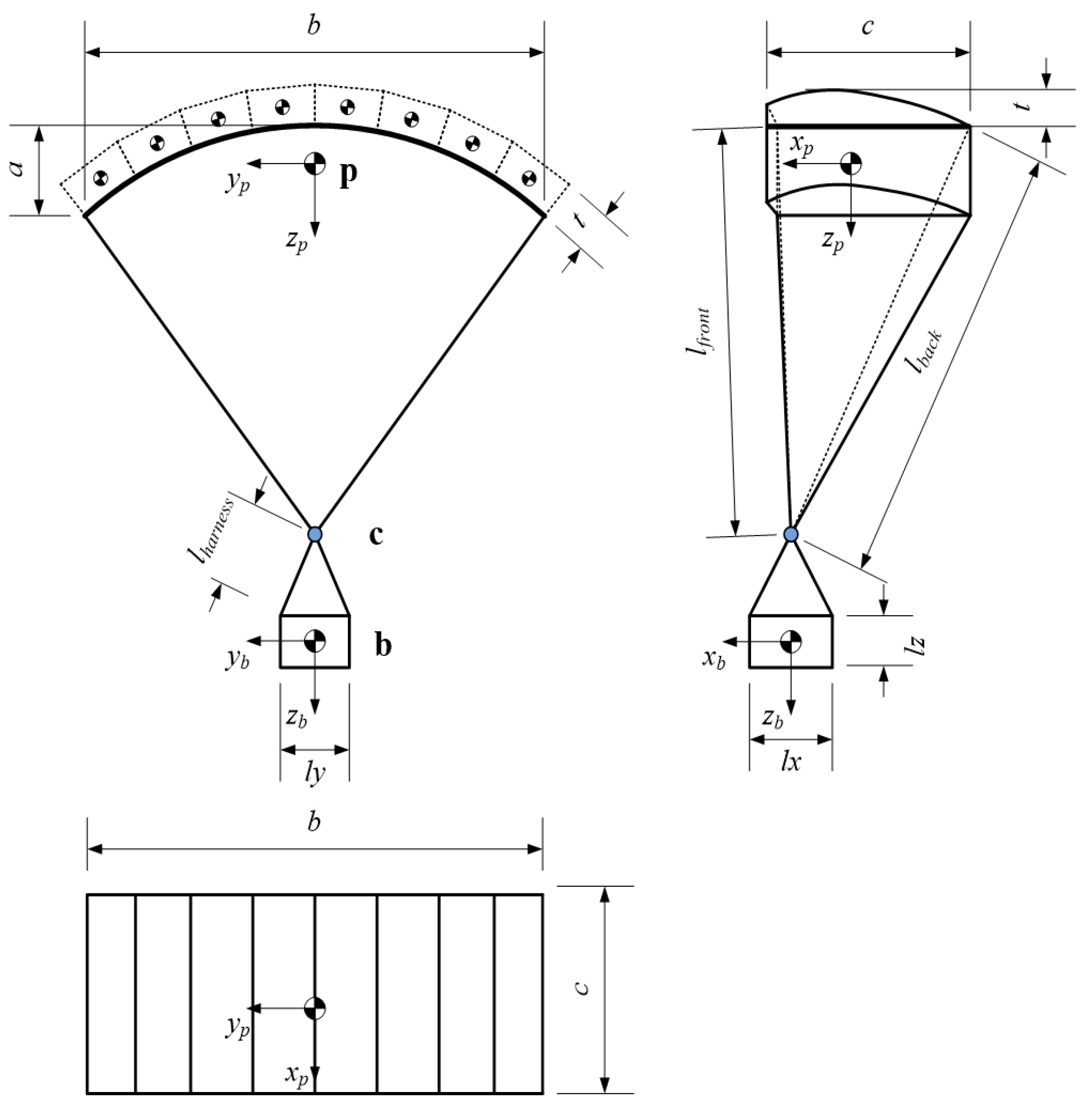
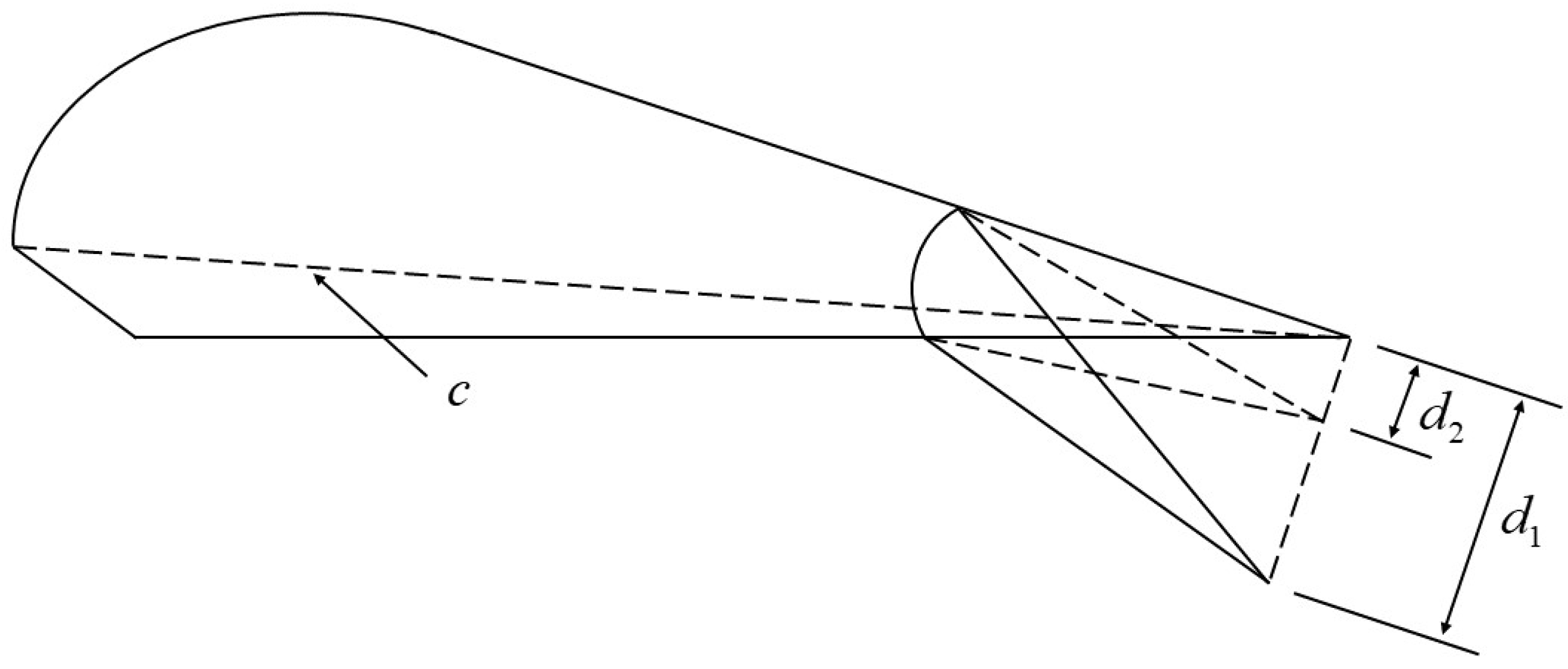




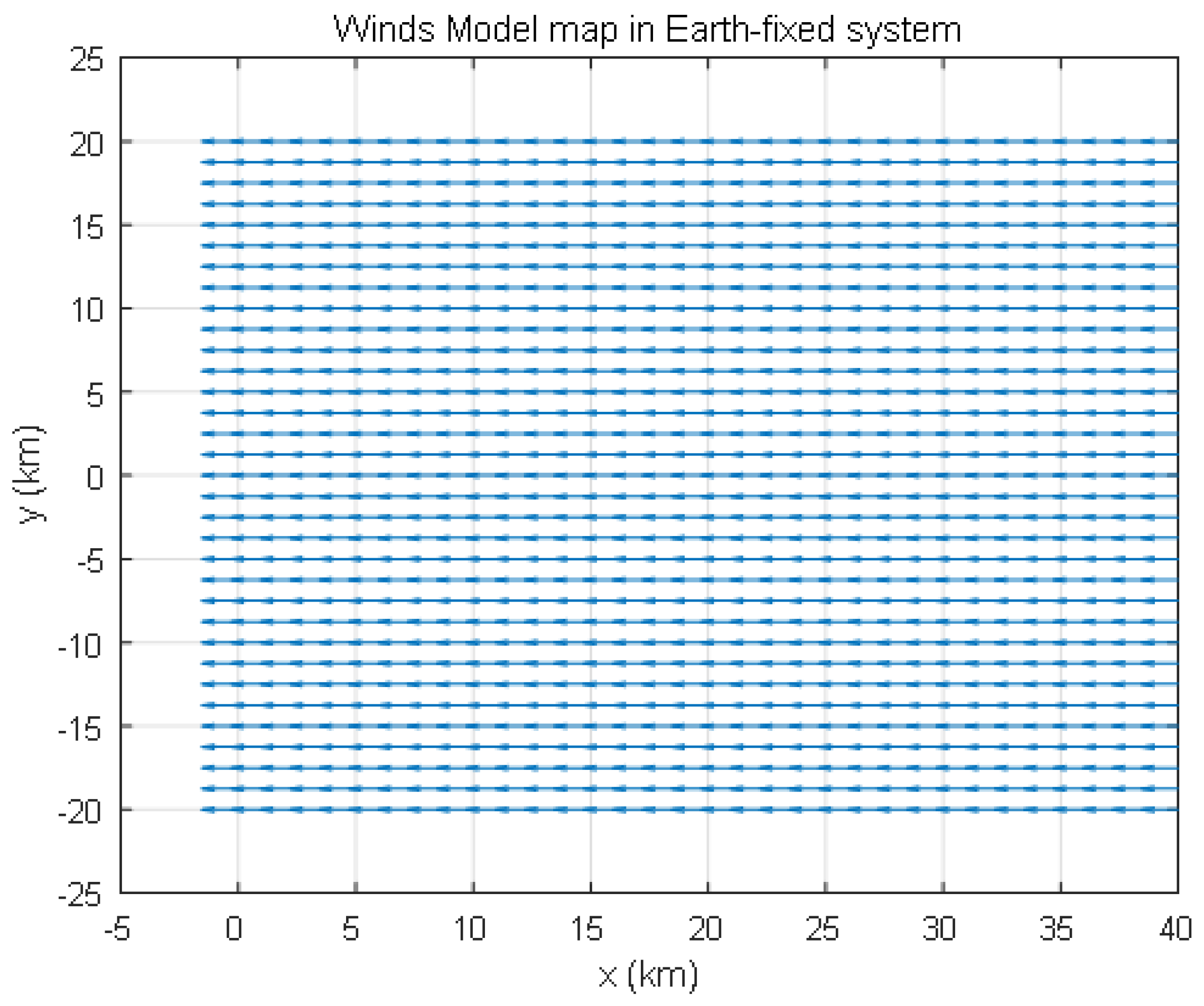
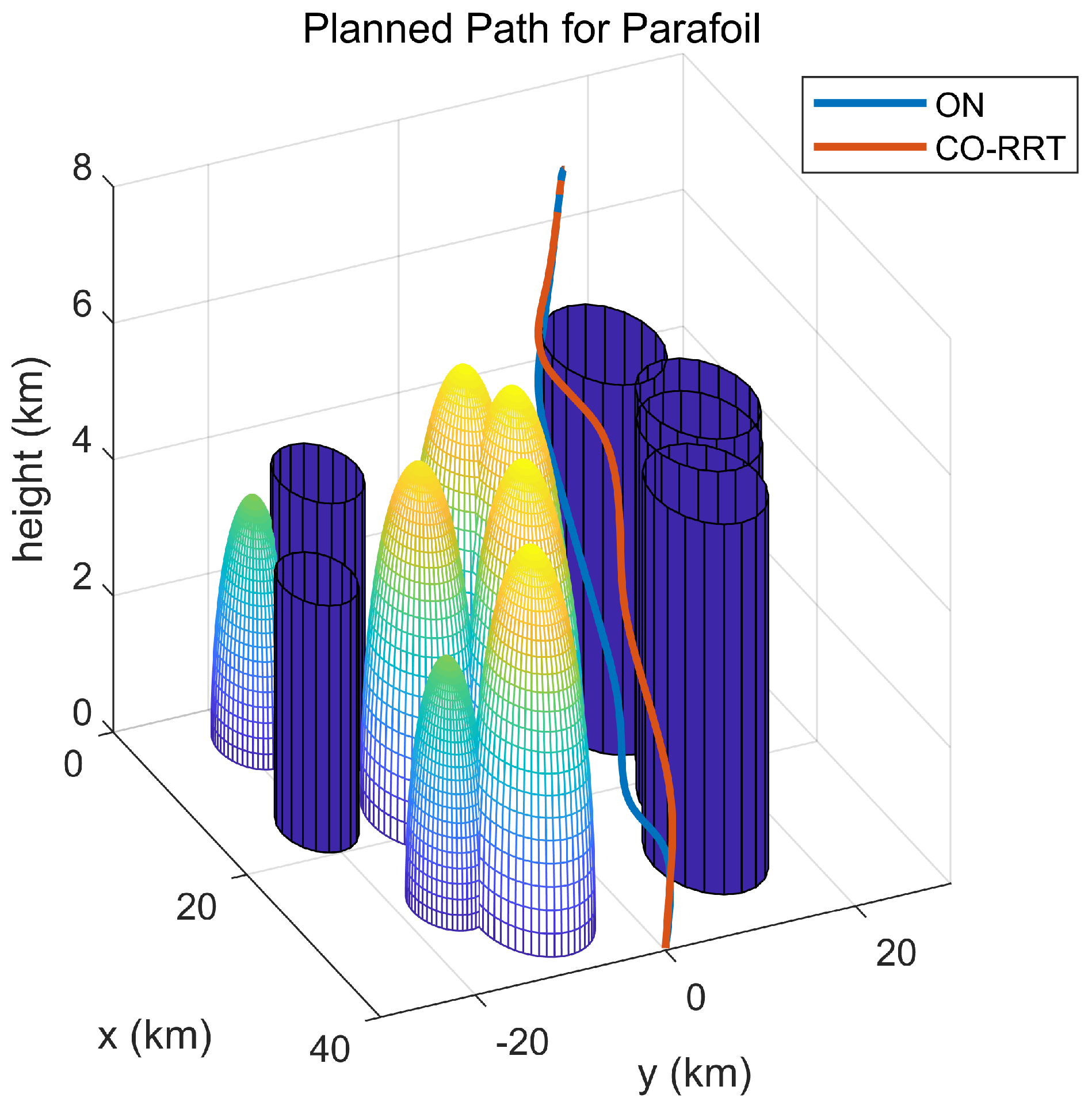
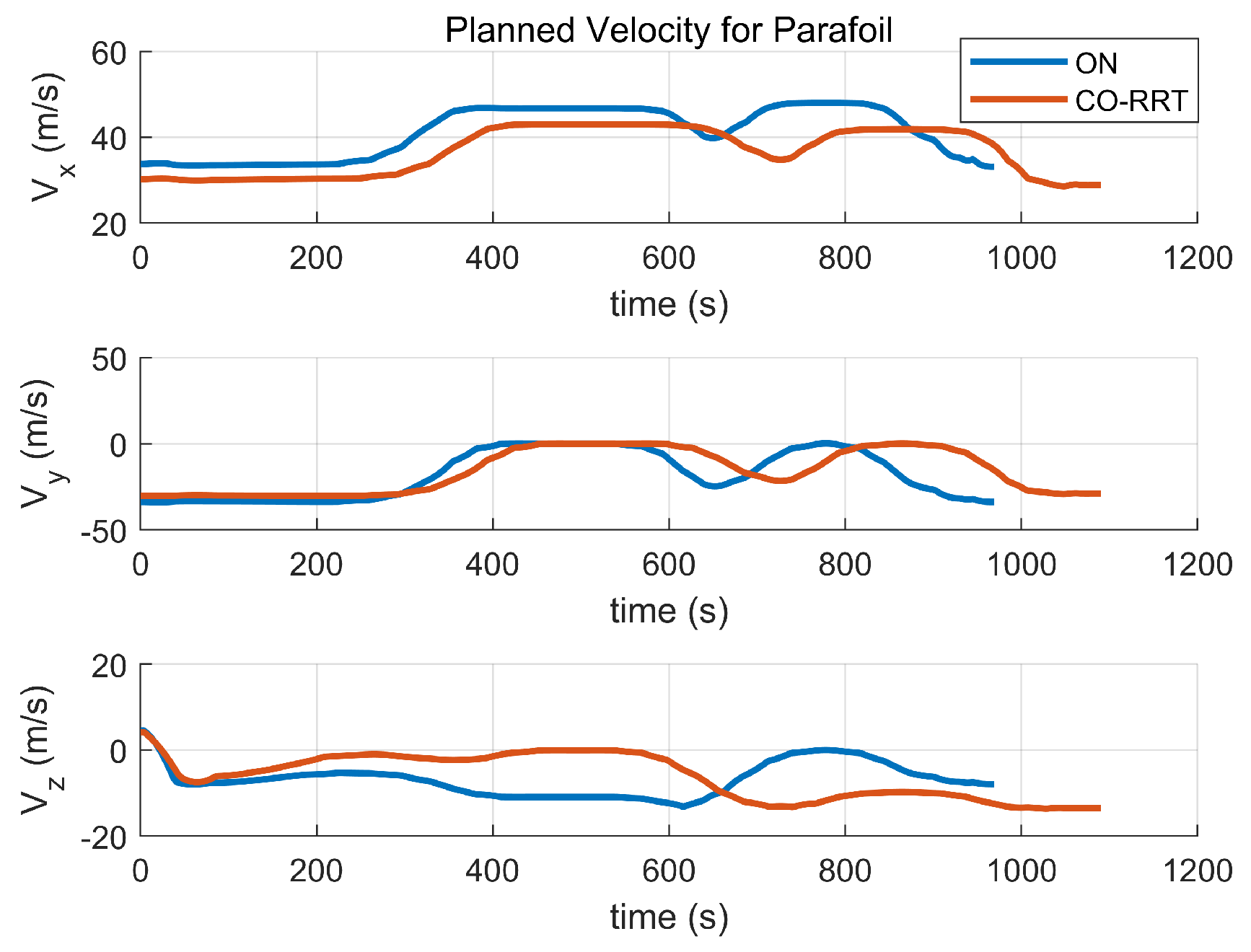
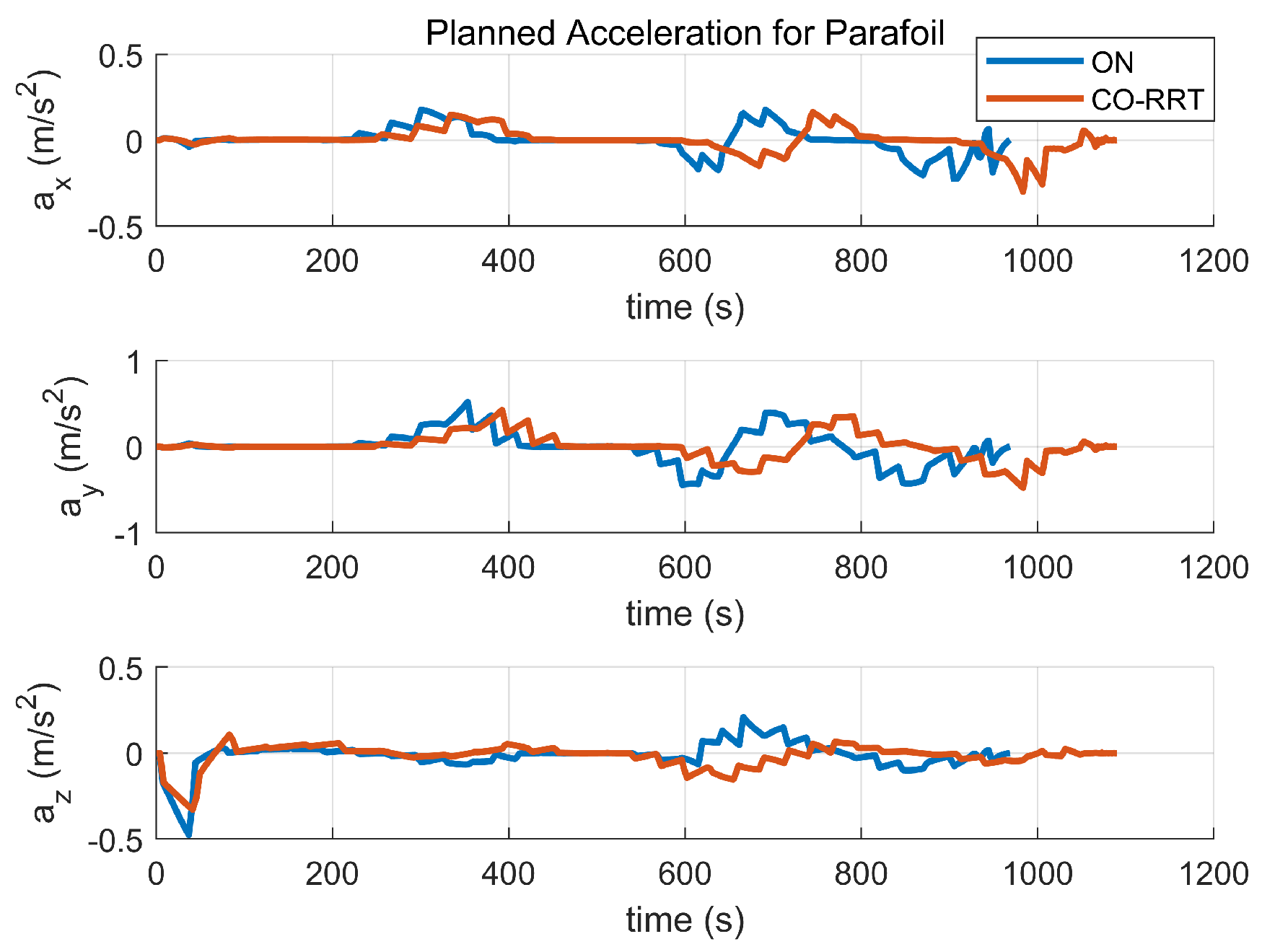
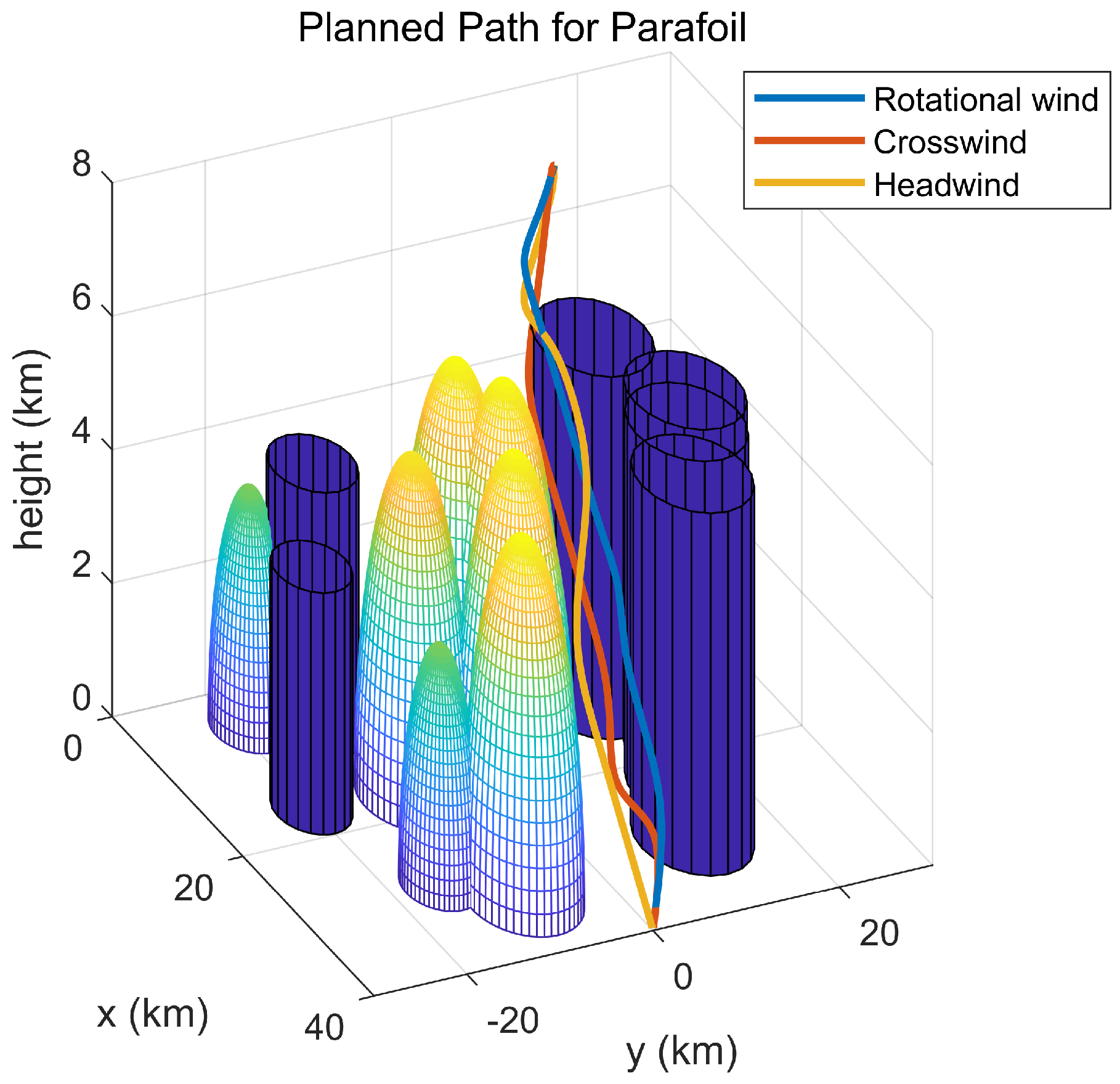
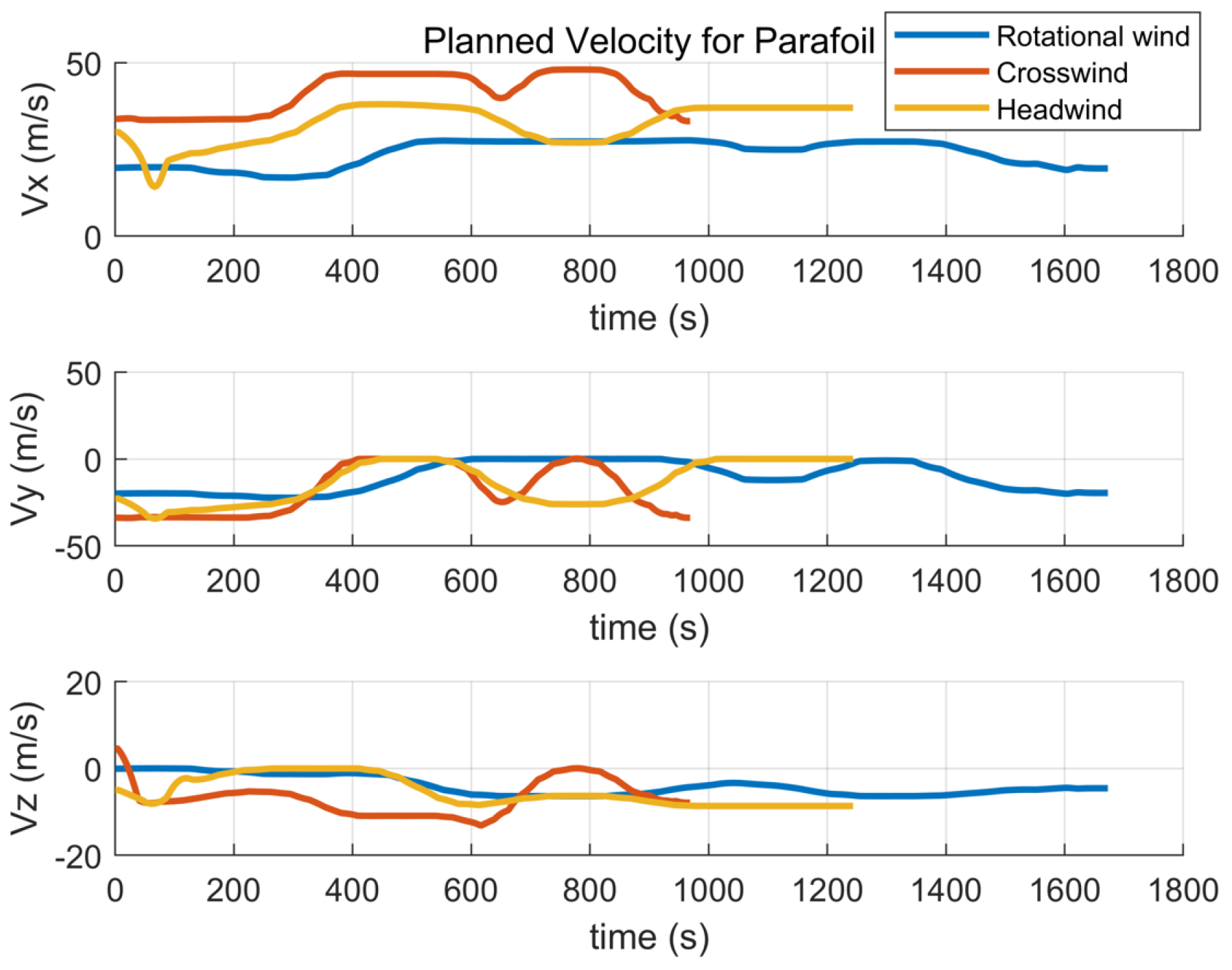
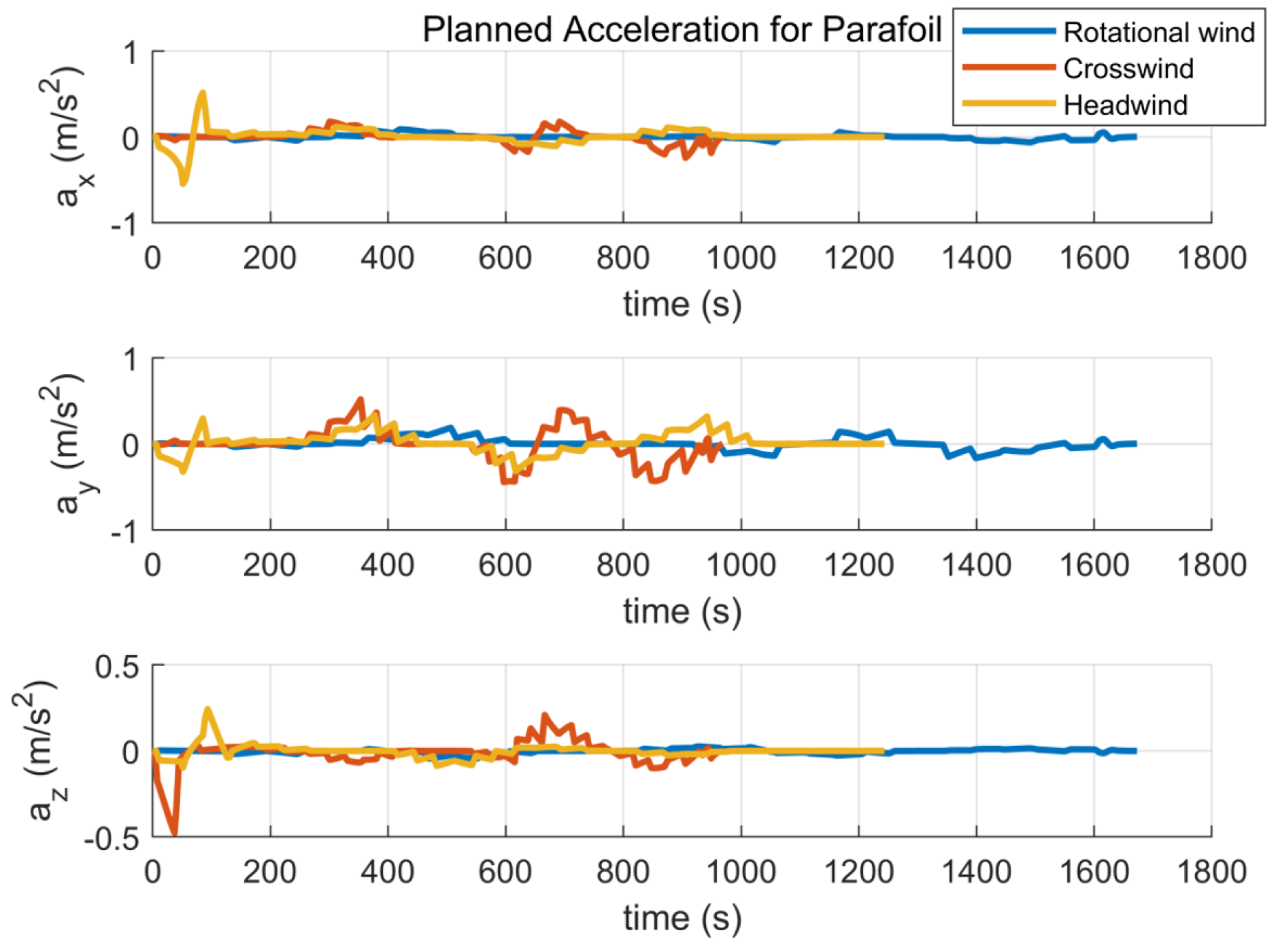
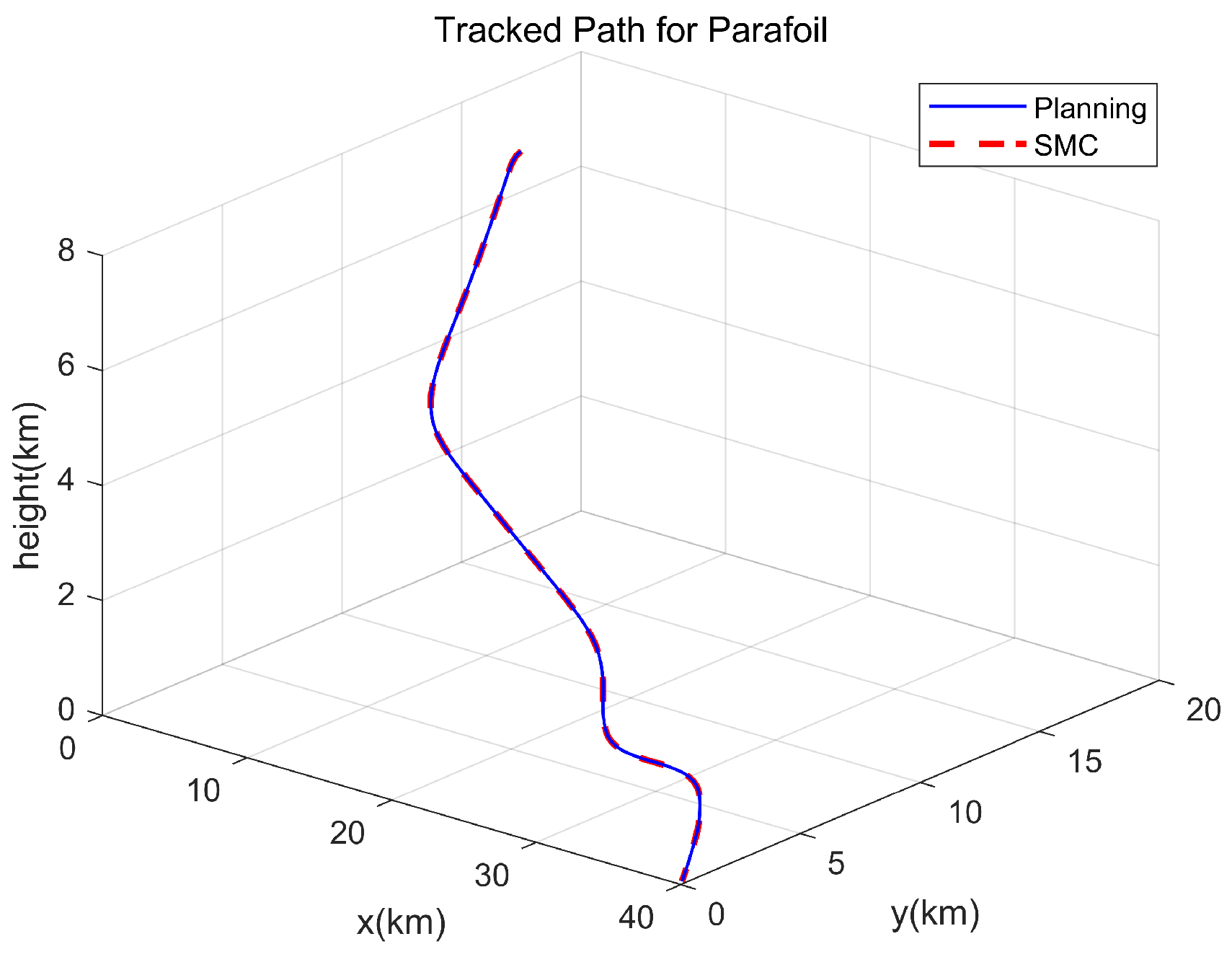
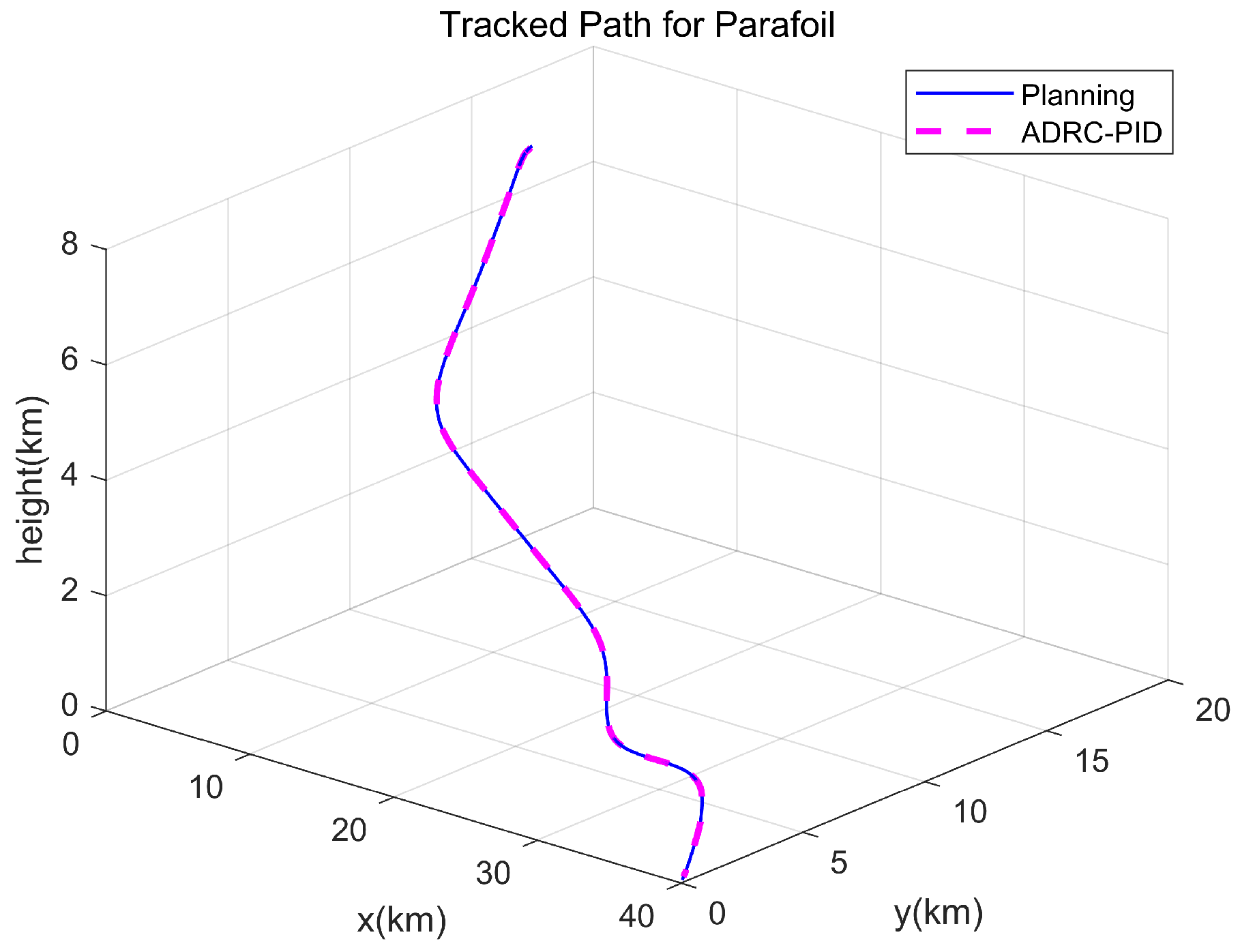
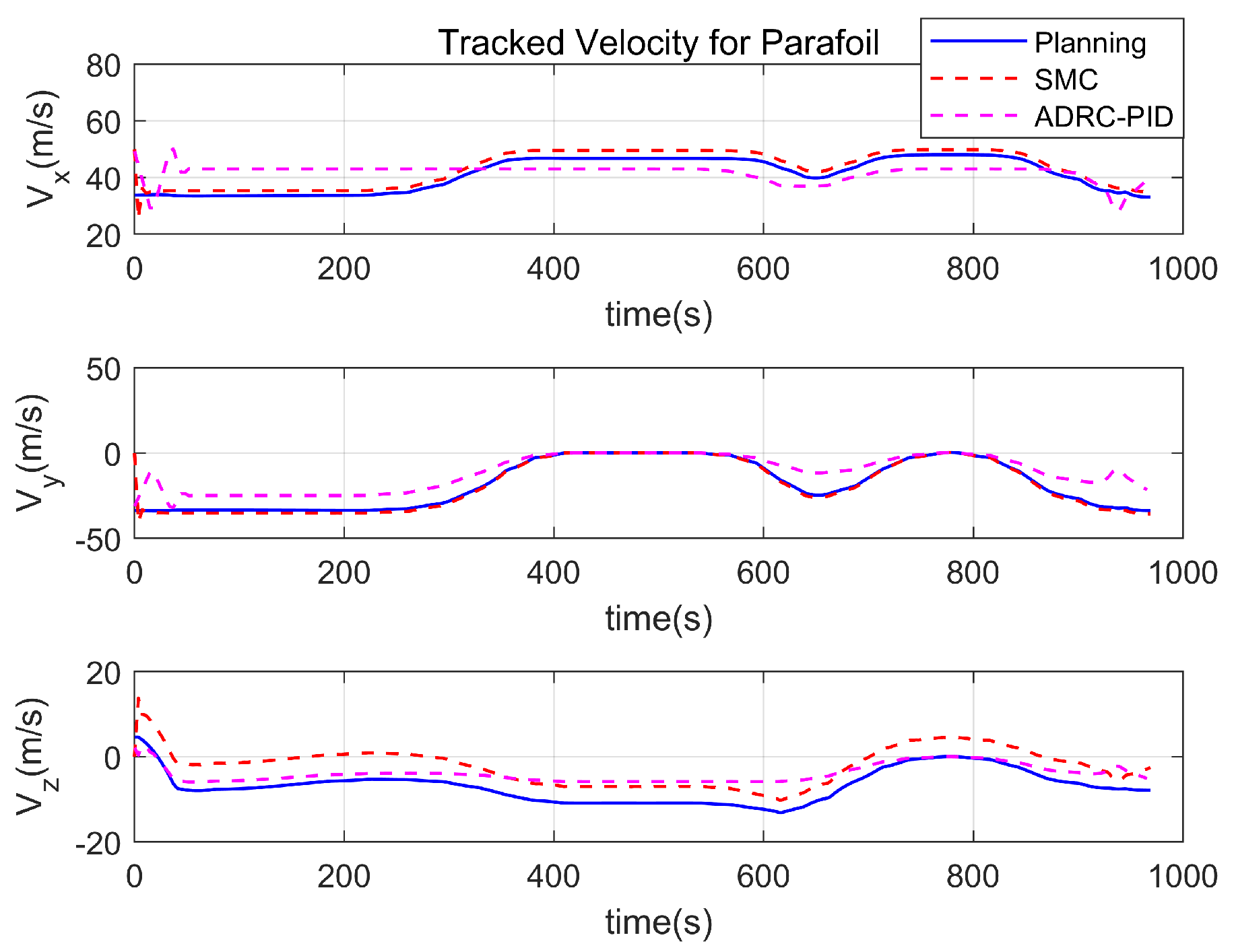
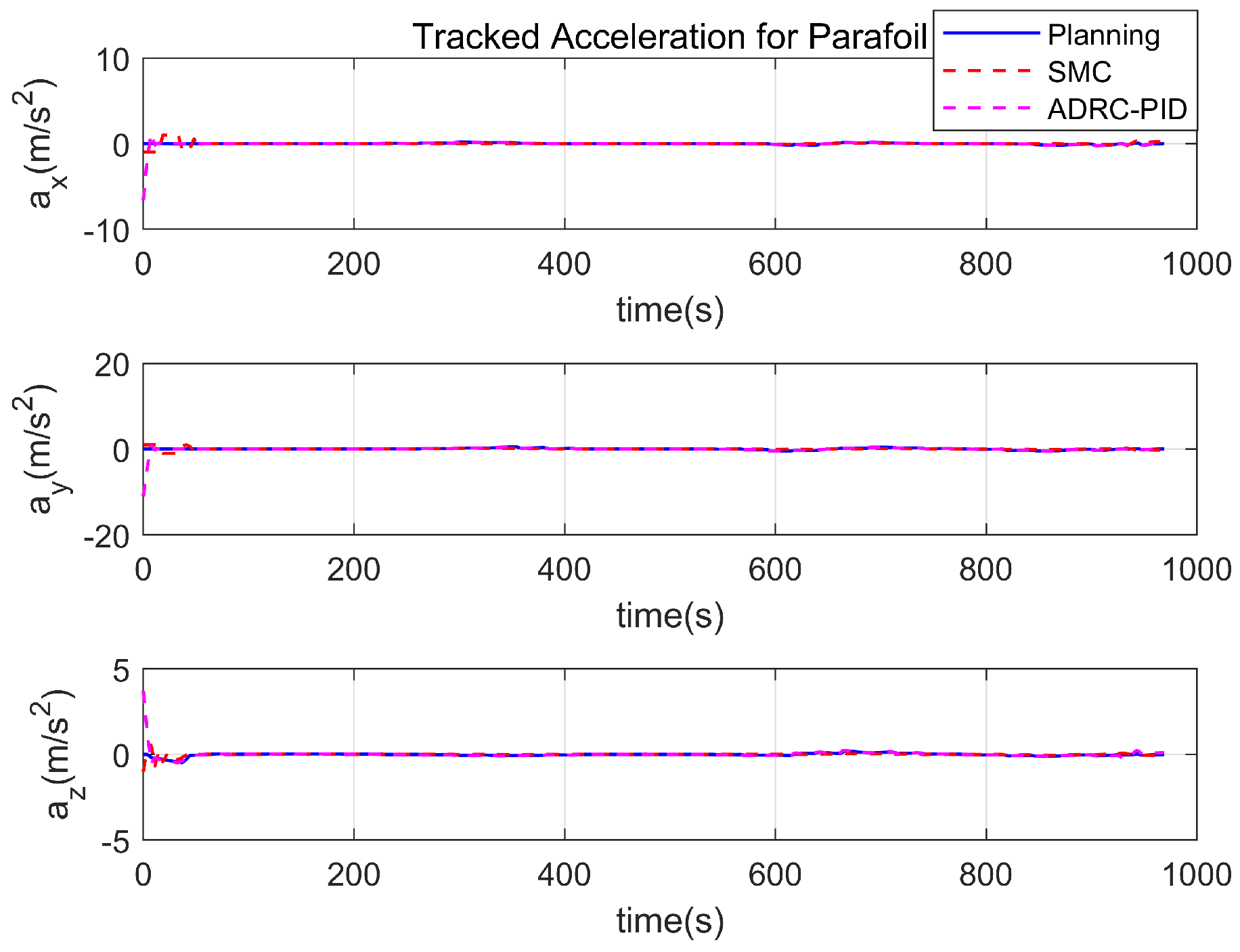

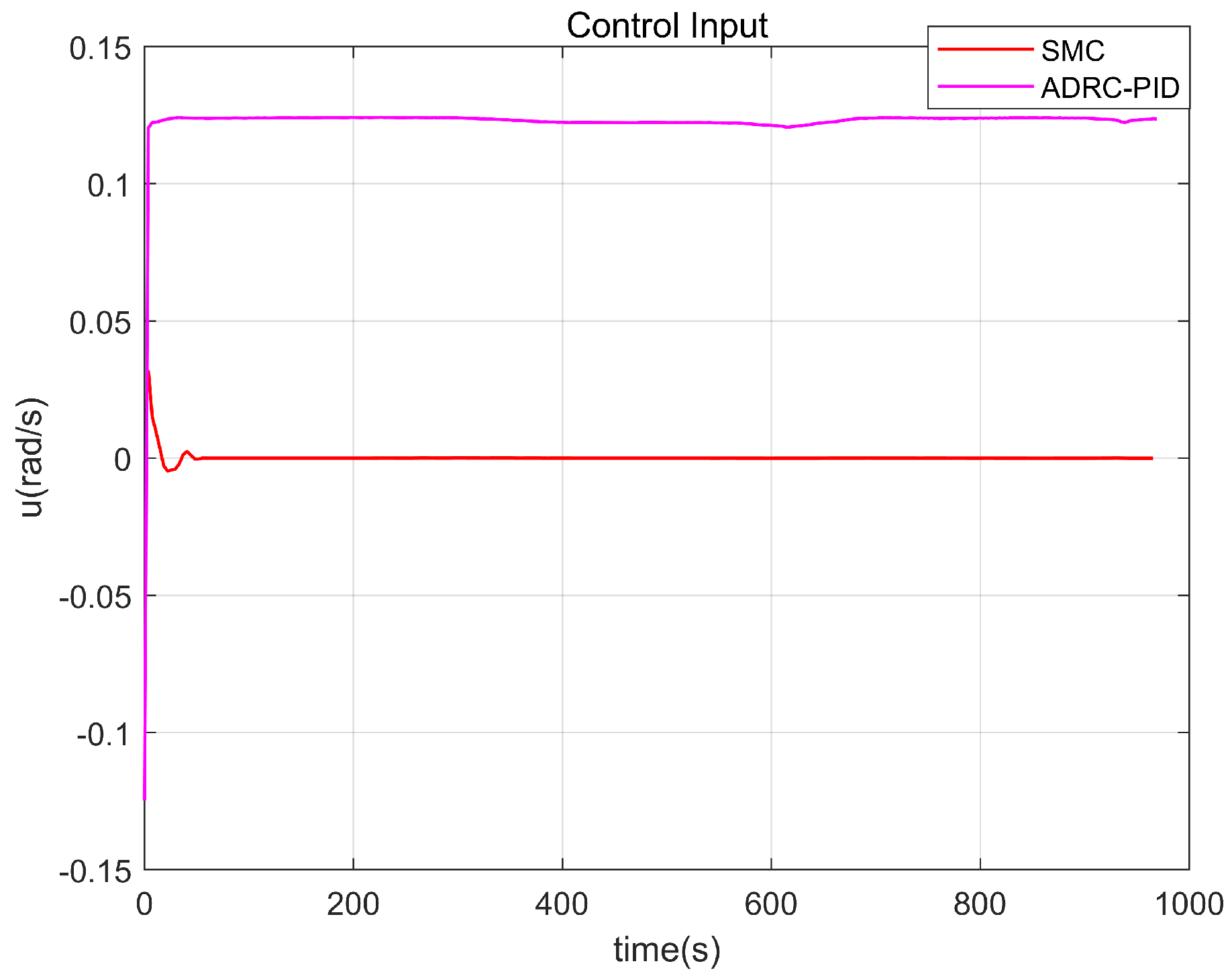
| Coefficients | Values | Coefficients | Values |
|---|---|---|---|
| −0.0095 | 0.2350 | ||
| −0.0060 | 0.0957 | ||
| −0.0014 | 0.1368 | ||
| −0.1330 | 0.2940 | ||
| 0.0100 | −0.0063 | ||
| 0.0005 | 0.0155 | ||
| −0.0130 | −1.864 | ||
| −0.0350 |
| Method | Wind Field | Starting Position/km | Landing Position/km |
|---|---|---|---|
| ON | Crosswind | [0, 17.5, 6.5] | [40, 0, 0] |
| CO–RRT | Crosswind | [0, 17.5, 6.5] | [40, 0, 0] |
| ON | Rotational wind | [0, 17.5, 6.5] | [40, 0, 0] |
| Crosswind | [0, 17.5, 6.5] | [40, 0, 0] | |
| Headwind | [0, 17.5, 6.5] | [40, 0, 0] |
| Method | Wind Field | Starting Position/km | Landing Position/km |
|---|---|---|---|
| SMC | Crosswind | [0, 17.5, 6.5] | [40, 0, 0] |
| ARDC–PID | Crosswind | [0, 17.5, 6.5] | [40, 0, 0] |
| Method | /m | /m | /m | /m | /m |
|---|---|---|---|---|---|
| SMC | 0.23 | 0.63 | 0.14 | 0.96 | 25.97 |
| ADRC–PID | 6.53 | 2.39 | 0.36 | 7.72 | 12.98 |
Disclaimer/Publisher’s Note: The statements, opinions and data contained in all publications are solely those of the individual author(s) and contributor(s) and not of MDPI and/or the editor(s). MDPI and/or the editor(s) disclaim responsibility for any injury to people or property resulting from any ideas, methods, instructions or products referred to in the content. |
© 2023 by the authors. Licensee MDPI, Basel, Switzerland. This article is an open access article distributed under the terms and conditions of the Creative Commons Attribution (CC BY) license (https://creativecommons.org/licenses/by/4.0/).
Share and Cite
Li, Z.; Nan, Y. Optimal Path Planning and Tracking Control Methods for Parafoil. Appl. Sci. 2023, 13, 8115. https://doi.org/10.3390/app13148115
Li Z, Nan Y. Optimal Path Planning and Tracking Control Methods for Parafoil. Applied Sciences. 2023; 13(14):8115. https://doi.org/10.3390/app13148115
Chicago/Turabian StyleLi, Zhihan, and Ying Nan. 2023. "Optimal Path Planning and Tracking Control Methods for Parafoil" Applied Sciences 13, no. 14: 8115. https://doi.org/10.3390/app13148115





